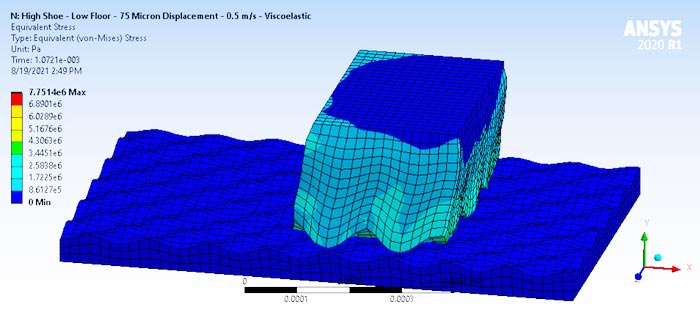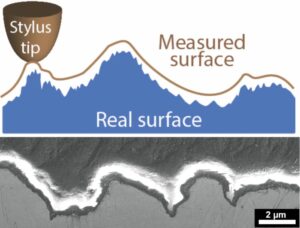Creating good friction: Pitt engineers aim to make floors less slippery

Finite element models are used to simulate interactions between rough shoe and floor surfaces. Rubber materials absorb energy when they deform. Flooring peaks deform the rubber material when the two are sliding against each other causing energy to be absorbed. This absorbed energy is the origin for some of the friction forces that prevent a slip.
Credit: University of Pittsburgh
Swanson School collaborators Kurt Beschorner and Tevis Jacobs will use a NIOSH award to measure floor-surface topography and create a predictive model of friction.
Friction is the resistance to motion of one surface or object moving relative to another. The frictional relationship between two objects has beneficial effects: when you strike a match, friction lights a flame; when you use your vehicle’s brakes, friction helps bring it to a stop. This same relationship, when leveraged properly, can help prevent slips and falls in the workplace.

Credit: University of Pittsburgh
Friction is caused, in part, by small features on the two surfaces in contact. Even if a floor may look smooth there is still some degree of topography; however, these roughness features can be difficult to measure, especially on a small scale. The University of Pittsburgh’s Kurt Beschorner and Tevis Jacobs will use an award from the National Institute for Occupational Safety & Health (NIOSH) to measure roughness on the smallest scales ever measured. They will use those measurements to build a model of friction performance with the long-term goal of innovating high-friction flooring to prevent occupational slips and falls.
“More than 140,000 workers1 suffer from fall-related injuries each year, and about half of them result from a slip,” said Beschorner, associate professor of bioengineering. “Designing specific, high-friction flooring could mitigate these injuries, but we need a better understanding of the flooring factors that lead to friction.”
“To date, despite research worldwide, no one has yet reliably connected flooring topography to friction measurements for flooring,” said Eric Astrachan, executive director of the Tile Council of North America. “This is the ‘Holy Grail’ for flooring design, where an understanding of measurable topography parameters — parameters that also affect aesthetics and cleanability — can be used in the design phase to engineer flooring slip resistance.”
Studies suggest that small-scale topography — raised features resembling a mountain range on the micron or nanometer scale — is key to managing slips on a surface. Beschorner and Jacobs will measure this type of floor-surface topography and create a predictive model of friction based on the results.
“For this project, we will combine traditional measurements with metrics that can target smaller scales, including scanning electron microscopy,” said Beschorner, associate professor of bioengineering.
Traditionally, researchers would use stylus profilometry to measure surface topography, but that technique has its limitations, particularly on a small-scale.
“Stylus profilometry sort of functions like a record player — a sharp needle is dragged across the surface, measuring its height as it moves. But this device does not effectively detect the small features that are critical for shoe-floor friction,” said Jacobs, associate professor of mechanical and materials science. “Instead, we are cutting out a cross-section of the flooring and using electron microscopy, which can measure features that are one thousand times smaller. These new measurements will allow us to establish the science behind roughness-dependent friction, rather than just using trial and error to find the best surfaces.”
Slips and falls in the workplace have an annual cost of $10 billion in workers’ compensation. This work is expected to lead to improved high-friction flooring that can help prevent these accidents and save both companies and employees the inconvenience of these injuries.
“Dr. Beschorner and Dr. Jacobs at the University of Pittsburgh are uniquely qualified to conduct this research that can directly impact worker and consumer safety, a key priority of the Tile Council of North America and our member companies,” Astrachan said. “It is our pleasure to facilitate this research through direct connections to the TCNA Product Performance Testing Laboratory and to the research and production departments of our members.”
1: U.S. Bureau of Labor Statistics, Databases, Tables & Calculators by Subject (Data from 2018): CSU00X0000006E100, CSU00X42XXXX6E100, CSU00X0000007E100, and CSU00X42XXXX7E100, U.S. Department of Labor, Editor. 2020, Department of Labor.
Media Contacts
Paul Kovach
University of Pittsburgh
paulkovach@pitt.edu
Leah Russell
University of Pittsburgh, Swanson School of Engineering
llr19@pitt.edu
All latest news from the category: Studies and Analyses
innovations-report maintains a wealth of in-depth studies and analyses from a variety of subject areas including business and finance, medicine and pharmacology, ecology and the environment, energy, communications and media, transportation, work, family and leisure.
Newest articles

Innovative 3D printed scaffolds offer new hope for bone healing
Researchers at the Institute for Bioengineering of Catalonia have developed novel 3D printed PLA-CaP scaffolds that promote blood vessel formation, ensuring better healing and regeneration of bone tissue. Bone is…

The surprising role of gut infection in Alzheimer’s disease
ASU- and Banner Alzheimer’s Institute-led study implicates link between a common virus and the disease, which travels from the gut to the brain and may be a target for antiviral…

Molecular gardening: New enzymes discovered for protein modification pruning
How deubiquitinases USP53 and USP54 cleave long polyubiquitin chains and how the former is linked to liver disease in children. Deubiquitinases (DUBs) are enzymes used by cells to trim protein…



